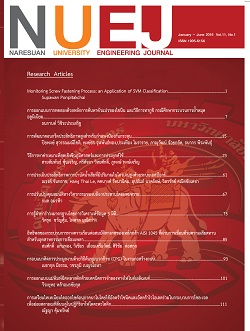A Framework of Cost Plus Gas (CPG) Bidding Method for Road Construction that Reducing Greenhouse Gas Emissions using Incentive.
Main Article Content
Abstract
Article Details
References
Intergovernmental Panel on Climate Change (IPCC). Fifth Assessment Report - Synthesis Report, 2014, [Online]. Available: http://www.ipcc.ch/assessment-report/ar5/syr/ SYR _AR5_FINAL _full.pdf
United Nations Framework Convention on Climate Change (UNFCC). Kyoto Protocol, 1998, [Online]. Available: http://unfccc.int/kyoto_protocol/items/2830.php
K. Park, Y. Hwang, S. Seo, and H. Seo, “Quantitative Assessment of Environmental Impacts on Life Cycle of Highways,” Journal of Construction Engineering and Management, vol. 129, no. 1, pp. 25–31, 2003.
Office of National Environmental Policy and Planning (ONEP). Ministry of Natural Resources and Environment, “2nd Thailand’s National GHG Inventories Report.” Bangkok, 2010.
U.S. Environmental Protection Agency (EPA), “Quantifying Greenhouse Gas Emissions from Key Industrial Sectors in the United States.” [Online]. Available: http://archive.epa.gov/sectors/web/pdf/greenhouse-report.pdf
A. Eštoková, and M. Porhinčák, “Reduction of Primary Energy and CO2 Emissions Through Selection and Environmental Evaluation of Building Materials,” Theoretical Foundations of Chemical Engineering, vol. 46, no. 6, pp. 704–712, 2012.
H. G. Avetisyan, E. Miller-Hooks, and S. Melanta, “Decision Models to Support Greenhouse Gas Emissions Reduction from Transportation Construction Projects,” Journal of Construction Engineering and Management, vol. 138, no. 5, pp. 631–641, 2012.
C. Ahn, F. Peña-Mora, S. Lee, and C. A. Arboleda, “Consideration of the Environmental Cost in Construction Contracting for Public Works: A+C and A+B+C Bidding Methods,” Journal of Management in Engineering, vol. 29, no. 1, pp. 86–94, 2013.
J. A. Fava, “Why take a life cycle approach?: United Nations Publication,” 2004, [Online]. Available: http://www.unep.fr/ scp/publications /details.asp?id=DTI/0585/PA
M. Finkbeiner, A. Inaba, B. H. R. Tan, K. Christiansen, and H.-J. Klüppel, “The New International Standards for Life Cycle Assessment: ISO 14040 and ISO 14044,” International Journal of Life Cycle Assessment, vol. 11, no. 2, pp. 80–85, 2006.
Society of Environmental Toxicology and Chemistry (SETAC), “Guidelines for Social Life Cycle Assessment of Products,” 2009, [Online]. Available: http://www. unep.fr/scp /publications/details.asp?id=DTI/1164/PA
T. Hong, C. Ji, M. Jang, and H. Park, “Assessment Model for Energy Consumption and Greenhouse Gas Emissions during Building Construction,” Journal of Management in Engineering, vol. 30, no. 2, pp. 226–235, 2014.
M. Metham, and V. Benjaoran, “Comparison Greenhouse Gas Emissions Due to Different Construction Techniques on Road Construction Project,” In Press: Technical Education Journal King Mongkut’s University of Technology North Bangkok, vol. 8, no. 2, 2017.
Michigan Department of Transportation, “Innovative Construction Contracting Guide,” [Online]. Available: http://www.michigan.gov/documents/mdot/Innovative_Construction_Contracting_340000_7.pdf
Minnesota Department of Transportation, “Innovative Contracting Guidelines,” [Online]. Available: http://www.dot.state.mn.us/const/tools/docs/Guidelines Dec 2008.pdf
K. El-Rayes, “Optimum Planning of Highway Construction under A + B Bidding Method,” Journal of Construction Engineering and Management, vol. 127, no. 4, pp. 261–269, 2001.
J. G. Vogtländer, H. C. Brezet, and Ch. F. Hendriks, “The virtual eco-costs ’99, a single LCA-based indicator for sustainability and the eco-costs/value ratio (EVR) model for economic allocation.” International Journal of Life Cycle Assessment, vol. 6, no. 3, pp. 157–166, 2001.
M. Metham, and V. Benjaoran, “The Assessment of Greenhouse Gas Emissions for Evaluating Actual Road Construction Operations,” in Proc. 2015 31st Annual Association of Researchers in Construction Management Conf., pp.257-266.


